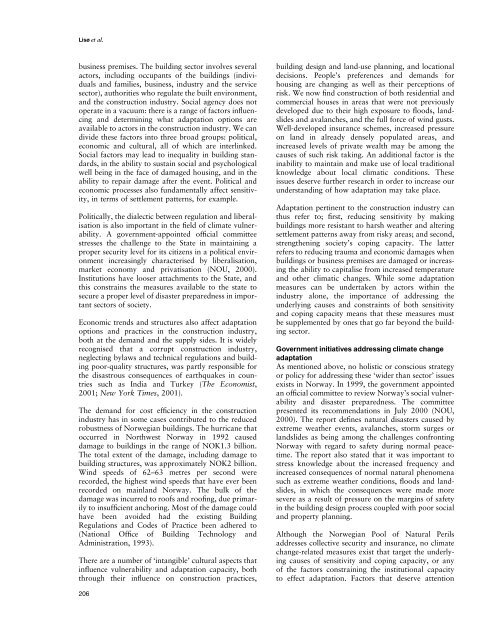Lisø PhD Dissertation Manuscript - NTNU
Lisø PhD Dissertation Manuscript - NTNU
Lisø PhD Dissertation Manuscript - NTNU
Create successful ePaper yourself
Turn your PDF publications into a flip-book with our unique Google optimized e-Paper software.
LisÖ et al.<br />
business premises. The building sector involves several<br />
actors, including occupants of the buildings (individuals<br />
and families, business, industry and the service<br />
sector), authorities who regulate the built environment,<br />
and the construction industry. Social agency does not<br />
operate in a vacuum: there is a range of factors influencing<br />
and determining what adaptation options are<br />
available to actors in the construction industry. We can<br />
divide these factors into three broad groups: political,<br />
economic and cultural, all of which are interlinked.<br />
Social factors may lead to inequality in building standards,<br />
in the ability to sustain social and psychological<br />
well being in the face of damaged housing, and in the<br />
ability to repair damage after the event. Political and<br />
economic processes also fundamentally affect sensitivity,<br />
in terms of settlement patterns, for example.<br />
Politically, the dialectic between regulation and liberalisation<br />
is also important in the field of climate vulnerability.<br />
A government-appointed official committee<br />
stresses the challenge to the State in maintaining a<br />
proper security level for its citizens in a political environment<br />
increasingly characterised by liberalisation,<br />
market economy and privatisation (NOU, 2000).<br />
Institutions have looser attachments to the State, and<br />
this constrains the measures available to the state to<br />
secure a proper level of disaster preparedness in important<br />
sectors of society.<br />
Economic trends and structures also affect adaptation<br />
options and practices in the construction industry,<br />
both at the demand and the supply sides. It is widely<br />
recognised that a corrupt construction industry,<br />
neglecting bylaws and technical regulations and building<br />
poor-quality structures, was partly responsible for<br />
the disastrous consequences of earthquakes in countries<br />
such as India and Turkey (The Economist,<br />
2001; New York Times, 2001).<br />
The demand for cost efficiency in the construction<br />
industry has in some cases contributed to the reduced<br />
robustness of Norwegian buildings. The hurricane that<br />
occurred in Northwest Norway in 1992 caused<br />
damage to buildings in the range of NOK1.3 billion.<br />
The total extent of the damage, including damage to<br />
building structures, was approximately NOK2 billion.<br />
Wind speeds of 62–63 metres per second were<br />
recorded, the highest wind speeds that have ever been<br />
recorded on mainland Norway. The bulk of the<br />
damage was incurred to roofs and roofing, due primarily<br />
to insufficient anchoring. Most of the damage could<br />
have been avoided had the existing Building<br />
Regulations and Codes of Practice been adhered to<br />
(National Office of Building Technology and<br />
Administration, 1993).<br />
There are a number of ‘intangible’ cultural aspects that<br />
influence vulnerability and adaptation capacity, both<br />
through their influence on construction practices,<br />
206<br />
building design and land-use planning, and locational<br />
decisions. People’s preferences and demands for<br />
housing are changing as well as their perceptions of<br />
risk. We now find construction of both residential and<br />
commercial houses in areas that were not previously<br />
developed due to their high exposure to floods, landslides<br />
and avalanches, and the full force of wind gusts.<br />
Well-developed insurance schemes, increased pressure<br />
on land in already densely populated areas, and<br />
increased levels of private wealth may be among the<br />
causes of such risk taking. An additional factor is the<br />
inability to maintain and make use of local traditional<br />
knowledge about local climatic conditions. These<br />
issues deserve further research in order to increase our<br />
understanding of how adaptation may take place.<br />
Adaptation pertinent to the construction industry can<br />
thus refer to; first, reducing sensitivity by making<br />
buildings more resistant to harsh weather and altering<br />
settlement patterns away from risky areas; and second,<br />
strengthening society’s coping capacity. The latter<br />
refers to reducing trauma and economic damages when<br />
buildings or business premises are damaged or increasing<br />
the ability to capitalise from increased temperature<br />
and other climatic changes. While some adaptation<br />
measures can be undertaken by actors within the<br />
industry alone, the importance of addressing the<br />
underlying causes and constraints of both sensitivity<br />
and coping capacity means that these measures must<br />
be supplemented by ones that go far beyond the building<br />
sector.<br />
Government initiatives addressing climate change<br />
adaptation<br />
As mentioned above, no holistic or conscious strategy<br />
or policy for addressing these ‘wider than sector’ issues<br />
exists in Norway. In 1999, the government appointed<br />
an official committee to review Norway’s social vulnerability<br />
and disaster preparedness. The committee<br />
presented its recommendations in July 2000 (NOU,<br />
2000). The report defines natural disasters caused by<br />
extreme weather events, avalanches, storm surges or<br />
landslides as being among the challenges confronting<br />
Norway with regard to safety during normal peacetime.<br />
The report also stated that it was important to<br />
stress knowledge about the increased frequency and<br />
increased consequences of normal natural phenomena<br />
such as extreme weather conditions, floods and landslides,<br />
in which the consequences were made more<br />
severe as a result of pressure on the margins of safety<br />
in the building design process coupled with poor social<br />
and property planning.<br />
Although the Norwegian Pool of Natural Perils<br />
addresses collective security and insurance, no climate<br />
change-related measures exist that target the underlying<br />
causes of sensitivity and coping capacity, or any<br />
of the factors constraining the institutional capacity<br />
to effect adaptation. Factors that deserve attention














![Diagnosis and FTC by Prof. Blanke [pdf] - NTNU](https://img.yumpu.com/12483948/1/190x245/diagnosis-and-ftc-by-prof-blanke-pdf-ntnu.jpg?quality=85)

